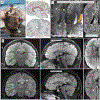Decision-making in stereotactic epilepsy surgery
- PMID: 35908245
- PMCID: PMC9669234
- DOI: 10.1111/epi.17381
Decision-making in stereotactic epilepsy surgery
Abstract
Surgery can cure or significantly improve both the frequency and the intensity of seizures in patients with medication-refractory epilepsy. The set of diagnostic and therapeutic interventions involved in the path from initial consultation to definitive surgery is complex and includes a multidisciplinary team of neurologists, neurosurgeons, neuroradiologists, and neuropsychologists, supported by a very large epilepsy-dedicated clinical architecture. In recent years, new practices and technologies have emerged that dramatically expand the scope of interventions performed. Stereoelectroencephalography has become widely adopted for seizure localization; stereotactic laser ablation has enabled more focal, less invasive, and less destructive interventions; and new brain stimulation devices have unlocked treatment of eloquent foci and multifocal onset etiologies. This article articulates and illustrates the full framework for how epilepsy patients are considered for surgical intervention, with particular attention given to stereotactic approaches.
Keywords: epilepsy; neurosurgery; stereotaxy.
© 2022 International League Against Epilepsy.
Figures












Similar articles
-
[Stereoelectroencephalography (seeg): a brief historical review of modern deep electrode implantation methods used for diagnosis and treatment of epilepsy].Zh Vopr Neirokhir Im N N Burdenko. 2021;85(2):99-106. doi: 10.17116/neiro20218502199. Zh Vopr Neirokhir Im N N Burdenko. 2021. PMID: 33864674 Russian.
-
Analysis of Morbidity and Outcomes Associated With Use of Subdural Grids vs Stereoelectroencephalography in Patients With Intractable Epilepsy.JAMA Neurol. 2019 Jun 1;76(6):672-681. doi: 10.1001/jamaneurol.2019.0098. JAMA Neurol. 2019. PMID: 30830149 Free PMC article.
-
Imaging and Stereotactic Electroencephalography Functional Networks to Guide Epilepsy Surgery.Neurosurg Clin N Am. 2024 Jan;35(1):61-72. doi: 10.1016/j.nec.2023.09.001. Epub 2023 Sep 23. Neurosurg Clin N Am. 2024. PMID: 38000842 Free PMC article. Review.
-
Stereoelectroencephalography-Guided Radiofrequency Thermocoagulation of Epileptic Foci in the Eloquent Motor Cortex: Feasibility, Safety, and Efficacy.World Neurosurg. 2022 Aug;164:e492-e500. doi: 10.1016/j.wneu.2022.04.133. Epub 2022 May 7. World Neurosurg. 2022. PMID: 35537694
-
Epilepsy Surgery: Monitoring and Novel Surgical Techniques.Neurol Clin. 2021 Aug;39(3):723-742. doi: 10.1016/j.ncl.2021.04.001. Epub 2021 Jun 9. Neurol Clin. 2021. PMID: 34215384 Review.
Cited by
-
Implantation and reimplantation of intracranial EEG electrodes in patients considering epilepsy surgery.Epilepsia Open. 2023 Dec;8(4):1622-1627. doi: 10.1002/epi4.12846. Epub 2023 Nov 1. Epilepsia Open. 2023. PMID: 37873557 Free PMC article.
-
Feasibility, Safety, and Performance of Full-Head Subscalp EEG Using Minimally Invasive Electrode Implantation.Neurology. 2024 Jun 25;102(12):e209428. doi: 10.1212/WNL.0000000000209428. Epub 2024 Jun 6. Neurology. 2024. PMID: 38843489 Free PMC article.
-
Functional mapping of movement and speech using task-based electrophysiological changes in stereoelectroencephalography.J Neurosurg. 2024 Aug 30;142(2):311-323. doi: 10.3171/2024.5.JNS24434. Print 2025 Feb 1. J Neurosurg. 2024. PMID: 39213665 Free PMC article.
-
High-resolution multimodal profiling of human epileptic brain activity via explanted depth electrodes.JCI Insight. 2025 Jan 9;10(1):e184518. doi: 10.1172/jci.insight.184518. JCI Insight. 2025. PMID: 39541170 Free PMC article.
-
A motor association area in the depths of the central sulcus.Nat Neurosci. 2023 Jul;26(7):1165-1169. doi: 10.1038/s41593-023-01346-z. Epub 2023 May 18. Nat Neurosci. 2023. PMID: 37202552 Free PMC article.
References
-
- Kwan P, Brodie MJ. Early identification of refractory epilepsy N Engl J Med 2000. Feb 3;342:314–319. - PubMed
-
- Callaghan BC, Anand K, Hesdorffer D, Hauser WA, French JA. Likelihood of seizure remission in an adult population with refractory epilepsy Ann Neurol 2007. Oct;62:382–389. - PubMed
-
- Luciano AL, Shorvon SD. Results of treatment changes in patients with apparently drug-resistant chronic epilepsy Ann Neurol 2007. Oct;62:375–381. - PubMed
-
- Kwan P, Schachter SC, Brodie MJ. Drug-resistant epilepsy N Engl J Med 2011. Sep 8;365:919–926. - PubMed
-
- Jobst BC, Cascino GD. Resective epilepsy surgery for drug-resistant focal epilepsy: a review JAMA 2015. Jan 20;313:285–293. - PubMed

